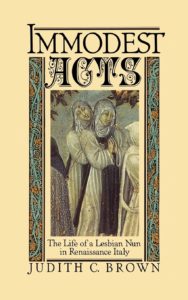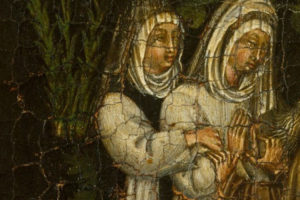Benedetta Carlini – First Lesbian Nun Story
Benedetta Carlini (1590-1661) was a mystic, seductress and nun. Dr. Judith C. Brown chronicled her life in the 1986 book, Immodest Acts. The book came on the heels of Rosemary Curb and Nancy Manahan’s bestseller, Lesbian Nuns: Breaking Silence, which was published in 1985. Benedetta was Abbess of the Convent of the Mother of God in Pescia, Italy when she was accused of heresy and “female sodomy.” Her story is important not only as a documented lesbian relationship in the convent, but how an intelligent, persuasive woman gained, experienced and exercised power and celebrity within Catholicism’ male-dominated structure. In the end, she was brought low by jealousy and her own excesses. She also had miscalculated the tectonic shift in the Church from the Counter Reformation: principally an emphasis on correction of clerical abuses, and more emphasis on intellectual understanding vs. supernatural manifestations of divine favor.
The story of Abbess Benedetta Carlini was discovered by accident by Dr. Brown, a historian at Stanford University while she was researching the economic history of the region and the Medici rule. “I found Benedetta Carlini by chance, by leafing through an inventory of nearly forgotten documents in the State Archive of Florence. The entry in the inventory read: ‘Papers relating to a trial against Sister Benedetta Carlini of Vellano, abbess of the Theatine nuns of Pescia, who pretended to be a mystic, but who was discovered to be a woman of ill repute.’” This discovery of an ecclesiastical investigation contained what is probably the earliest account of a sexual relationship between two nuns. The documents concerning Abbess Benedetta Carlini consisted mostly of transcripts of a series of inquests between 1619 and 1623. 
In 1986, Dr. Brown published her book about Benedetta’s life, investigations, and trials. Titled Immodest Acts: The Life of a Lesbian Nun in Renaissance Italy. It was widely reviewed in both scholarly and popular journals and publications. I talked to Dr. Brown about speaking at the Conference for Catholic Lesbians (CCL) West Coast conference in May 1986. Unfortunately, she wasn’t available to participate. Too bad, because many scholars are dry and pedantic, and I found Dr. Brown to be both engaging and knowledgeable. She was one of a handful of women at that time to write an even-handed account of lesbianism who was not a lesbian herself. The book served as a prop in Su Friedrich’s sensational 1987 film, Damned If You Don’t.
Benedetta’s parents brought her to the convent in 1599 when she was nine years old. She entered the Sisters of the Immaculate Conception of the Virgin Mary, more commonly known as the Theatines. The order was founded in 1583 by the Venerable Ursula Benincasa, who was famous for her visions and piety. The fame she gained from her visions led some to accuse her of being possessed by a devil. In 1617, Ursula had her most famous vision, where Jesus (in some versions, Mary) appeared to her. In the vision Jesus praised her order and promised them salvation. Ursula died in 1618 at the age of 71. Benedetta grew up learning about Ursula’s visions and the fame and power that proceeded from them. 
Like the Venerable Ursula, Benedetta had visions. In 1613, when she was 23, she reported visions to the mother superior and her confessor. A young boy helped her climb the “Mountain of Perfection;” she was surrounded by wild animals, only to be saved by Jesus. In another vision, while praying one morning, she found herself “in a garden, surrounded by fruits and flowers.” Male figures came to dominate her visions—a beautiful youth, young men who beat her with sticks, chains, and swords; a handsome guardian angel named Splenditello, and Jesus himself. Over time, the visions increased in intensity and detail, and Benedetta became well known for them. Fearful that Sister Benedetta was being harassed by demonic forces, Sister Bartolomea Crivelli was assigned to share her cell, observe her, and help her if possible.
On the second Friday of Lent 1619, Benedetta received an unmistakable sign of divine favor, the stigmata. Prior to this event Benedetta and others in her community were unsure if her visions were divine or diabolical in origin; but by manifesting the wounds of Christ she proved their divinity.
Her celebrity as a mystic blossomed. That same year the Theatine nuns elected her as their abbess.
Shortly after her election, she began to deliver sermons to the other nuns. She spoke in a trance, an angel speaking through her, exhorting the nuns to purify themselves, and be grateful for Benedetta’s presence in their midst. In the months that followed, there were more trances and visitations: from St. Catherine of Siena and an angel—a beautiful youth in a white robe named Splenditello, even Jesus himself. They spoke from within Benedetta, at times with loving praise, other times harshly or issuing commandments, such as a ban on eating meat, eggs, and dairy products.
On May 20, 1619, Jesus appeared to Benedetta and told her he wanted to marry her in a special ceremony. He had specific ideas for the procession, the chapel decorations, list of guests and the ceremony itself. At the wedding, while the other nuns watched and listened, Benedetta claimed the Blessed Mother looked on benevolently while Jesus placed a gold ring on her finger. Speaking through her, Jesus said, “I would like that this, my bride, be empress of all the nuns.” He added that the Great Duke of Tuscany should be informed of her greatness. All those who did not obey, believe, and cherish her would be punished.
Although the nuns had gone along with Benedetta’s visions, the self-flagellation during trance-sermons and even a ban on salami and cheese; the wedding with Jesus and his dictate that they should obey her or face divine punishment was a step too far. They reported her to the ecclesiastical authorities, who investigated her twice between 1619 and 1623. They discovered that she had faked the stigmata by pricking herself with a needle; secretly ate salami and mortadella during her “ban” on meat and dairy and painted on her miraculous wedding ring with saffron.
But the most damning, was the confession of Sr. Bartolomea Crivelli, Benedetta’s assigned companion. She described her two-year affair with the abbess. The women met for sex at least three times a week. “Embracing her, she would put her under herself and kissing her as if she were a man, she would speak words of love to her. And she would stir so much on top of her that both of them corrupted themselves.” They also masturbated each other and had oral sex to orgasm. Mutual fondling carried a relatively light penalty—two years of penance, plus the loss of Benedetta’s status as abbess. The fact that Benedetta claimed “Splenditello” the angel committed the sexual acts allowed clerical investigators to classify all of Benedetta’s supernatural visions as diabolic in nature. In their report, investigators criticized Benedetta’s “immodest and lascivious language,” and “the great display of vanity” of her mystical marriage with Jesus. 
Benedetta, 36, was condemned to involuntary hermitage and spent the remaining 35 years of her life in solitary confinement. The only other mention of Benedetta is an August 1661 entry in an unnamed nun’s diary stating that Benedetta Carlini died at age 71 of fever and colic pains. The nun added that Benedetta was “always popular among the laity.” For her confession, Sr. Bartolomea Crivelli was spared any punishment. She died in 1660, a year before Benedetta.
Why the long solitary confinement? I suspect jealousy, anger at her duplicity, and fear that her charm and intelligence could help her reclaim a leadership position led some nuns to promote her isolation within the community. She would feel her losses every day. Church authorities wanted to discourage her dangerous popularity with the laity. Her supernatural claims were unwanted in the new age of science and Counter-Reformation.
There is no record of what Benedetta thought and felt after she was led to her lonely cell. Did she have any regrets? Did she revisit her visions– real, imagined or devised? Did her thoughts ever stray to Bartolomea, lying in her bed nearby?
Benedetta Carlini has been the inspiration or subject of films, plays and articles. They include:
Immodest Acts: The Life of a Lesbian Nun in Renaissance Italy by Judith Brown, Oxford University Press, 1986
Damned If You Don’t – a film by Su Friedrich in 1989. If you want to see the film, below are the links for streaming and for DVD
Vimeo streaming for $3.99
DVD for $24.99
Discourses of Desire: Sexuality and Christian Women’s Visionary Narratives,” by E. Ann Matter, Journal of Homosexuality, 1989-1990
Big Gay Portal to Hell, a podcast by Catherine Clune-Taylor on Caveat
Stigmata, a 2011 play by Carolyn Gage
Vile Affections: Based on the True Story of Benedetta Carlini, a 2006 play by Vanda
Benedetta Carlini: Lesbian Nun of Renaissance Italy, a play by director and playwright, Rosemary Rowe.
Benedetta, an upcoming film directed by Paul Verhoeven and starring Virginia Efira as Benedetta. The film is scheduled to premiere at the 2021 Cannes Film Festival.



October 14th, 2020 at 4:34 am
Glad to see you posting. Thought you had left us.
That’s a great story.
October 15th, 2020 at 5:10 am
Hi, Polo! Nope, still alive and kicking! With winter approaching, and less opportunity for golf and house projects, the pace of my writing should pick up. Glad to see you are well and safe.
June 30th, 2021 at 3:41 pm
“IMMODEST ACTS, The Life of a Lesbian Nun in Renaissance Italy” most
riveting book I’ve ever read, absolutely fascinating and highly informative.
Plan reading it many times over, such a great and very important account.
Thank you. A.
July 27th, 2021 at 12:50 pm
[…] Carlini sa narodila v roku 1591 v renesan?nom Taliansku, kde pôsobila a prežila svoj celý život. Pochádzala z […]